#Jyutping
Text
So I've been playing around with Cāngjié…
And I thought a post like this (similar to a post on Zhùyīn done by linghxr) may be of interest to some.
Edited: 10 Sep 2023
This post has gotten a little popular lately and on scrutinizing my own post again, I've come to the conclusion that I had made some mistakes in my given character examples.
Amended now. Namely, 「唔」 and 「龍」 have now been swapped over in the examples.
「唔」 is really the “3-parts”, and 「龍」 is indeed a “2-parts” character! Amendments are reflected in orange.
What (and who) is Cāngjié?
For those who may not know, Cāngjié is another way to input 漢字/汉字 (Hànzì — Chinese characters). It is way less popular than Pinyin (or even Zhuyin) but it still has its fans, and has a few advantages over the other two.
Cāngjié is also the name of the mythical figure in Chinese legend who is said to have been the inventor of 漢字/汉字, for which Cāngjié (the input system) was named after.
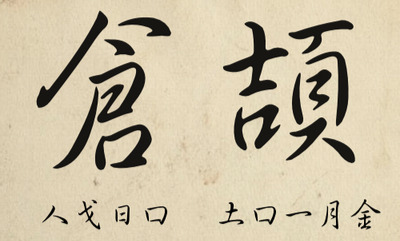
Would I recommend it?
Yes, if you think you have already acquired a good (enough) understanding of 漢字/汉字, and/or just like a new challenge.
(TL;DR at the end)
Why am I learning Cāngjié (and why you may like to, too)?
1. Mostly for fun.
Have long been intrigued by both Cāngjié and Zhùyīn, and since I finally mustered up the courage to tackle Zhùyīn not too long ago, I thought I'd finally give Cāngjié a try.
While learning Cāngjié does require more effort than learning Pinyin or Zhuyin, it can also be really fun! Inputting 漢字/汉字 with the Cāngjié method is almost like doing a jigsaw puzzle.
The euphoria derived from figuring out and piecing together the radicals that make up a word is something that learning Jyutping (Cantonese equivalent of Pinyin), Pinyin or Zhuyin can't quite match.
And while I know I'll never be as adept with Cāngjié — my knowledge of 漢字/汉字 is nowhere near good enough to ever use Cāngjié efficiently — as I do Jyutping or Pinyin (or to some extent, Zhuyin), it'll still be fun to use Cāngjié every once in a while!
2. Helps with thinking and typing in Chinese.
The upshot of relying too much on using Jyutping/Pinyin/Zhuyin is, I'd tend to think in Roman letters or ㄅㄆㄇㄈ before I'd even think about the actual 漢字/汉字.
But with Cāngjié, because it's based on knowing radicals and joining them together to form actual characters, it'll encourage thinking of 漢字/汉字 first, so I think that would help some with 漢字/汉字 memory retention.
Now you may be thinking, why not just you know, practise actually writing then? That is the tried and proven method to better remember 漢字/汉字 after all?
Yes, of course I can do that — and am doing so occasionally — but we live in a digital age now, and the probability and opportunity to type things out is much higher than actually writing stuff by hand.
The idea here is, more looking to think of and envision characters fully in my head, and trying to lessen over-reliance on Jyutping/Pinyin/Zhuyin.
And this is where I find Cāngjié can be useful, which leads to my next point…
3. Haunted by “What if” scenario.
What if there comes a day (however improbable) where I'm presented with only a Cāngjié keyboard to use for typing Chinese? It has happened with Zhùyīn for me!
That means, no Pinyin or Zhuyin keyboards, no Handwriting tools/touchscreens to write with fingers/mouse, no speech-to-text, and no option to copy-and-paste characters from somewhere else either! What then?
4. Able to type without knowing pronunciation, and with more accuracy.
Cāngjié is shape-based. Unlike Jyutping/Pinyin/Zhuyin, where you have to know what a character sounds like before you can type it out, with Cāngjié, you can type out (again assuming no Handwriting or other tools available) characters without needing to know how to pronounce them at all.
With shape-based typing, you'd also get more accurate hits in the first few 漢字/汉字 that show up, versus sound-based methods like Pinyin where for e.g., typing out “wan” will get you a whole list under the same sound and you may have to scroll through a whole lot to get the exact “wan” you need.
You can also type both Traditional and Simplified characters without having to toggle something or switch keyboards.
So how does one begin learning Cāngjié?
Install a Cāngjié keyboard.
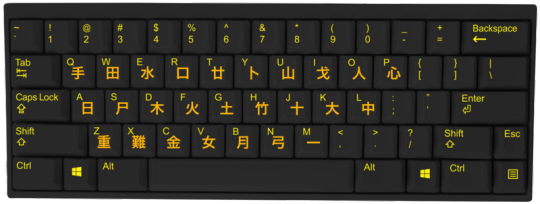
Duh…but of course! Heh! Gboard offers one, banded under Cantonese language input (Android user here, don't know about iPhones, sorry).
There are two versions of Cāngjié that are prevalent currently. Cāngjié 3 and Cāngjié 5. Cāngjié 5 is supposed to be an improvement over version 3 but I don't find there's much; having a slightly altered version just adds to the confusion and unnecessarily complicates matters, in fact!
If you have a choice, I'd recommend selecting Cāngjié 3 as that is more supported. Some operating systems may not be too compatible with Cāngjié 5 still, for some strange reason.


You may also come across something called “Quick” (速成) aka, “Simplified Cāngjié”.
This is simply a scaled down version of Cāngjié, it's still based on Cāngjié's formula. So you still need to know how Cāngjié works in order to use “Quick” efficiently.
You'd then need a chart like this. ↓

* the 重 (Z) key doesn't really come into use. I don't really know what it's for, but it seems to be used (paired with other keystrokes) mainly to type out various punctuation marks.
There are variants out there, some having a little more, or less, radicals shown than in the above example, but I'll say the chart here is one of the more comprehensive ones I've found so far (and sufficient enough) — other charts often fail to highlight the 難 (X) key and what it corresponds to.
You don't have to memorize the chart all at once. Just always have a chart like this on hand to refer to and with enough typing practise, you'll eventually remember which key corresponds with which radicals.
Remember the rules. ↓
“1 part” character (e.g. 寫) = first 3 & last (radical).
“2 parts” character (e.g. 唔龍) = first & last, first 2 & last.
“3 parts” character (e.g. 難) = first & last, first & last, last.
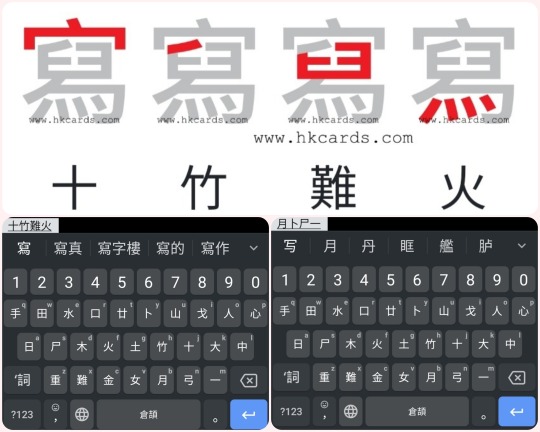
e.g. 寫 ↓
With radicals 宀,丿,臼 (first 3) and 灬 (last).
Corresponding keys: 十,竹,難 and 火。
寫 → 写 ↓
With radicals 冖,卜,㇆ (first 3),一 (last).
Corresponding keys:月,卜,尸 and 一。
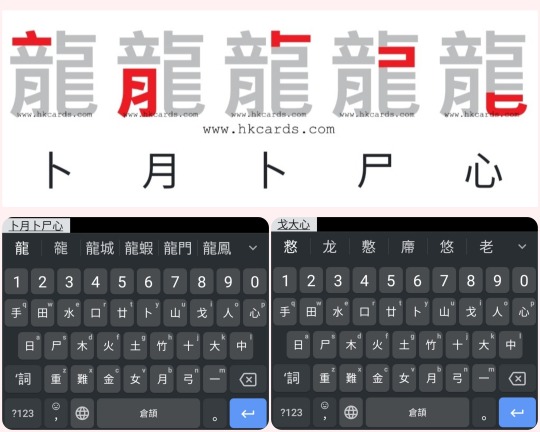
e.g. 龍 ↓
With radicals 亠,月 (first & last), 卜,コ (first 2),ヒ (last).
Corresponding keys: 卜,月,卜,尸,and 心。
龍 → 龙 ↓ (Simplified 龍 → 龙,a “1 part” character)
With radicals 丶,ナ,ヒ (first 3).
Corresponding keys: 戈,大,and 心。

e.g. 難 ↓
With radicals 廿,人 (first & last),亻(first & last),土 (last).
Corresponding keys: 廿,人,人 and 土。
難 → 难 ↓
With radicals ヌ (first & last),亻(first & last),土 (last).
Corresponding keys: 水,人,and 土。
Occasionally, you may get a character that looks like a “2 parts” but is actually a “3 parts”. ↓


e.g. 唔 ↓
With radicals 口 (first & last),一,一 (first & last),口 (last).
Corresponding keys: 口,一,一 and 口。
Or looks like a “1 part” but really a “3 parts”. ↓
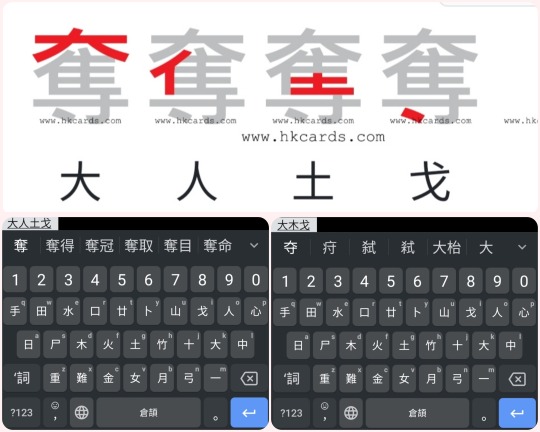
e.g. 奪 ↓
With radicals 大 (first & last),亻,土 (first & last),丶 (last).
Corresponding keys: 大,人,土,and 戈。
奪 → 夺 ↓(Simplified 奪 → 夺,a “1 part” character)
With radicals 大,寸 (first 3; the 丶 is the 3rd component).
Corresponding keys: 大,木,and 戈。
But these are exceptions, and don't occur that often.
And you can start practising!
You can try out this pretty good app called 『五色學倉頡』 (learning Cāngjié with 5 colours), for practise. It's on Playstore, just search for “Cangjie Dictionary” and it should show up.
You have to pay to unlock higher levels, unfortunately. ↓


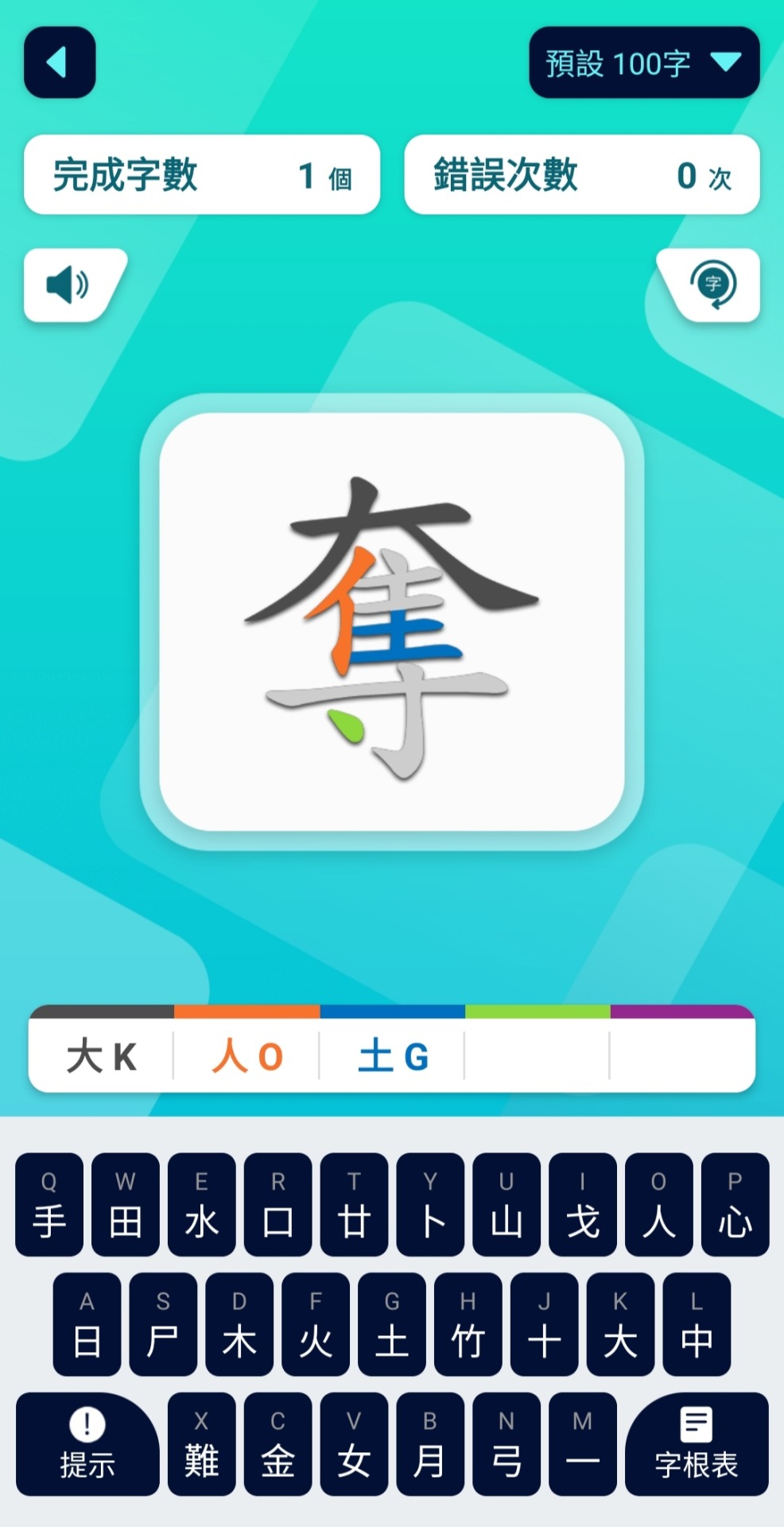
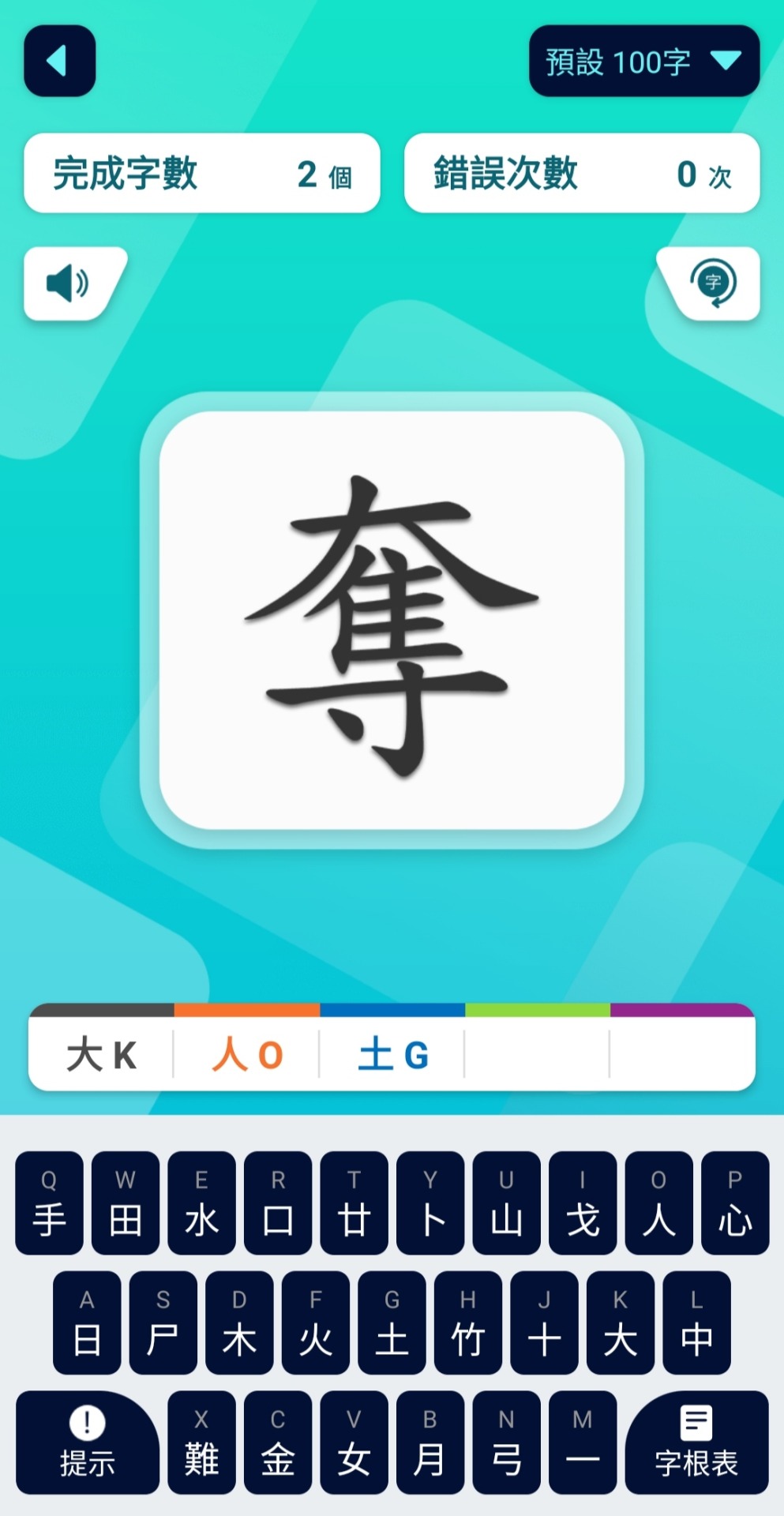


Anyway, each character comes with colour coded hints and you can opt to turn them off if you like more of a challenge. There are also hints (提示) and the chart (字根表) to refer to if you're really stuck. Also has a dictionary component (查字典) to check out the Cāngjié input for characters.
Another option would be a website called HKCards. ↓


You can use it to check the Cāngjié input for any 漢字/汉字, and there's section for practise (倉頡輸入法練習) as well. After inputting your answer with Cāngjié keys (手田水口廿卜), you can click on the “Answer” (答案) button to see how right or wrong your answers were. ↓

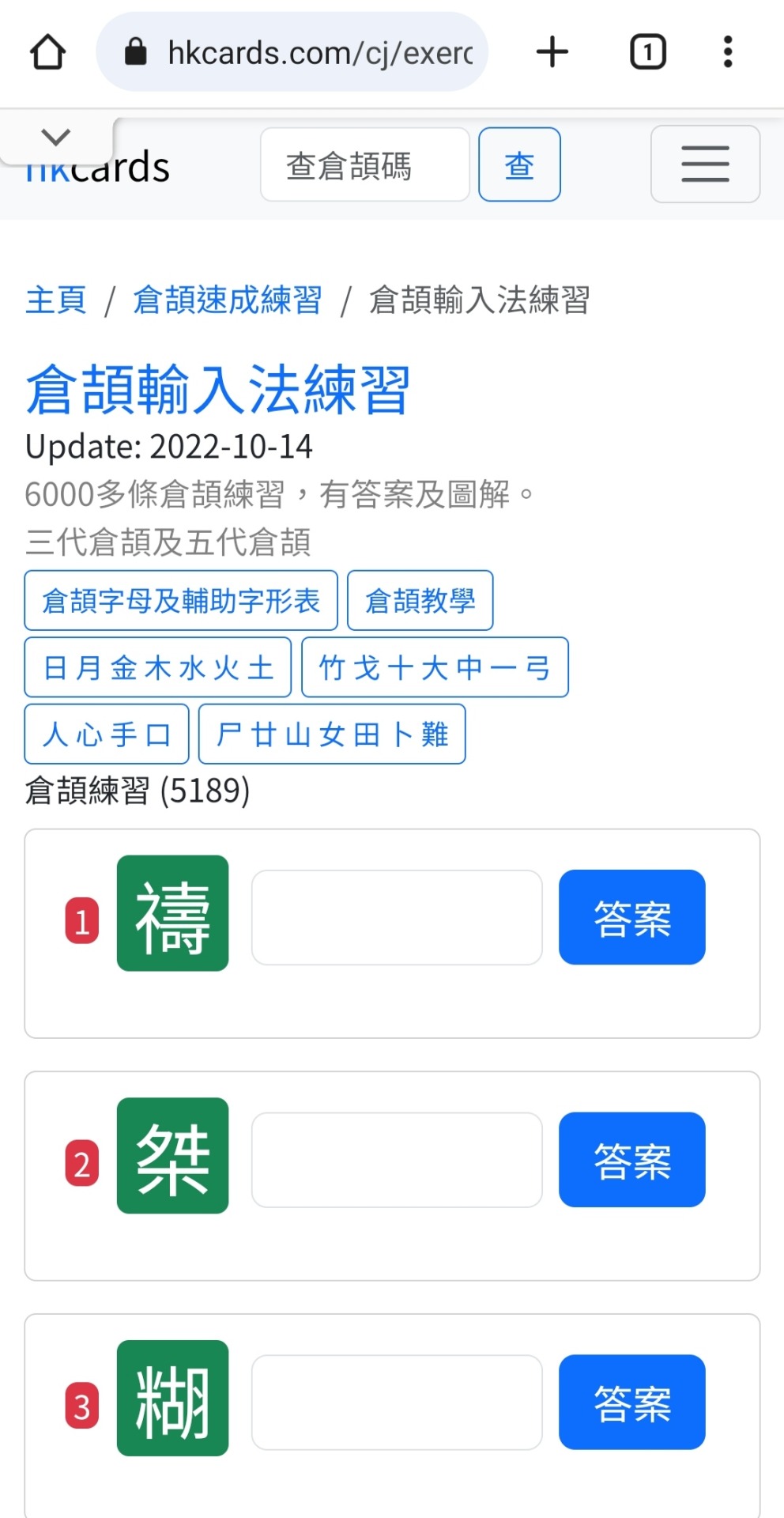
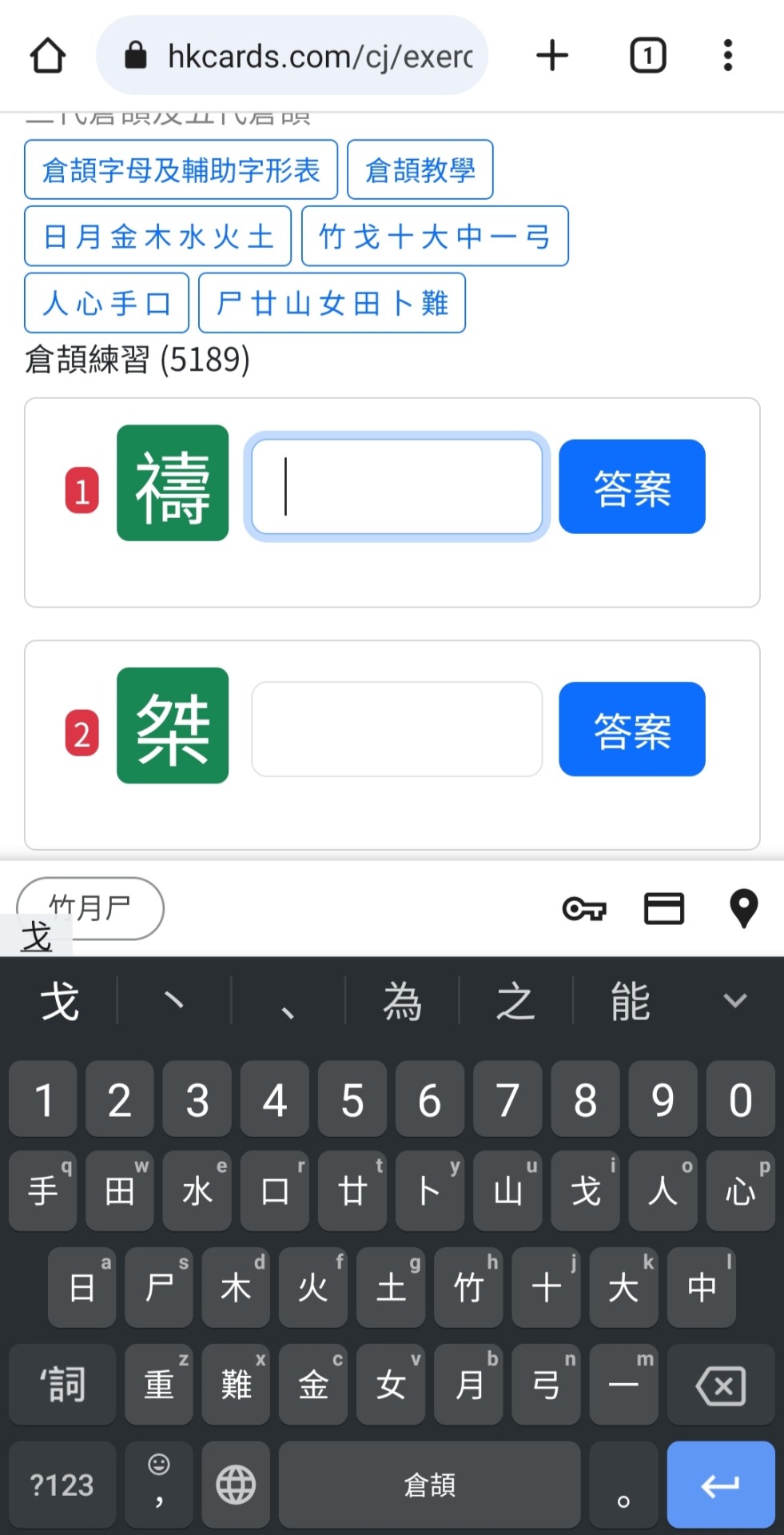

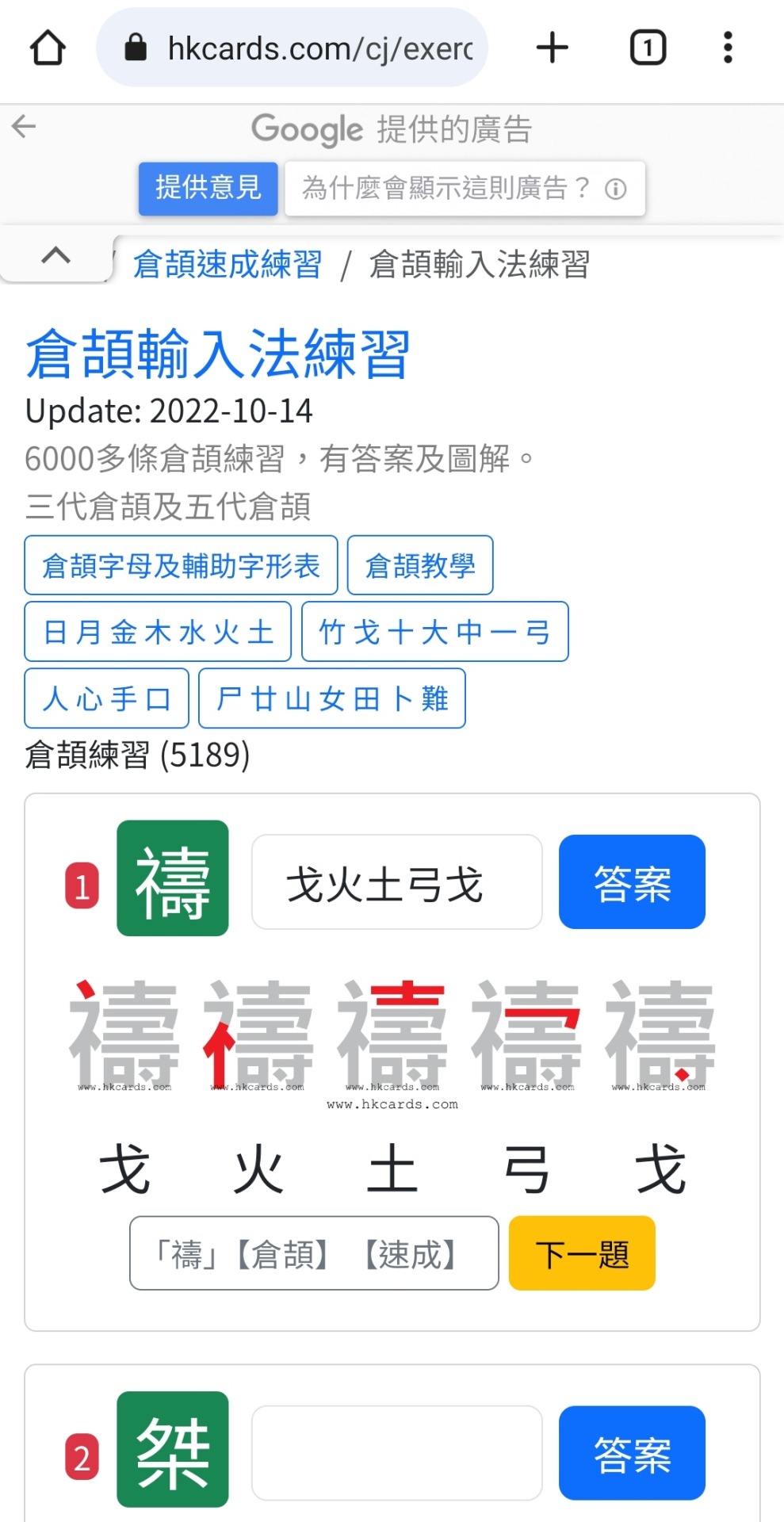
There are 8 characters each time, and you can just hit “Practise Again” (再做練習) to refresh for another 8 to practise with. I've yet to hit a limit.
Unfortunately, this website has lots of ads popping up. And it only supports searching in Traditional characters (Cāngjié was initially catered more for Traditional).
Or you can just try practising randomly with a Cāngjié keyboard and check for mistakes with a Cāngjié dictionary (『五色學倉頡』 app's dictionary comes in really useful here — it appears to support searching in Simplified too).
TL;DR
Cāngjié could be useful (and fun) to know if your 漢字/汉字 knowledge is already adequate, and/or you just like a new challenge.
And if watching videos is more your thing, here's a really helpful YouTube tutorial on how to use Cāngjié (has English subs)!
#Cangjie#Congkit#Cantonese#Mandarin#Jyutping#Pinyin#Zhuyin#Bopomofo#Traditional Characters#Chinese Language#Language#Long Post#Dake Rambles
243 notes
·
View notes
Text









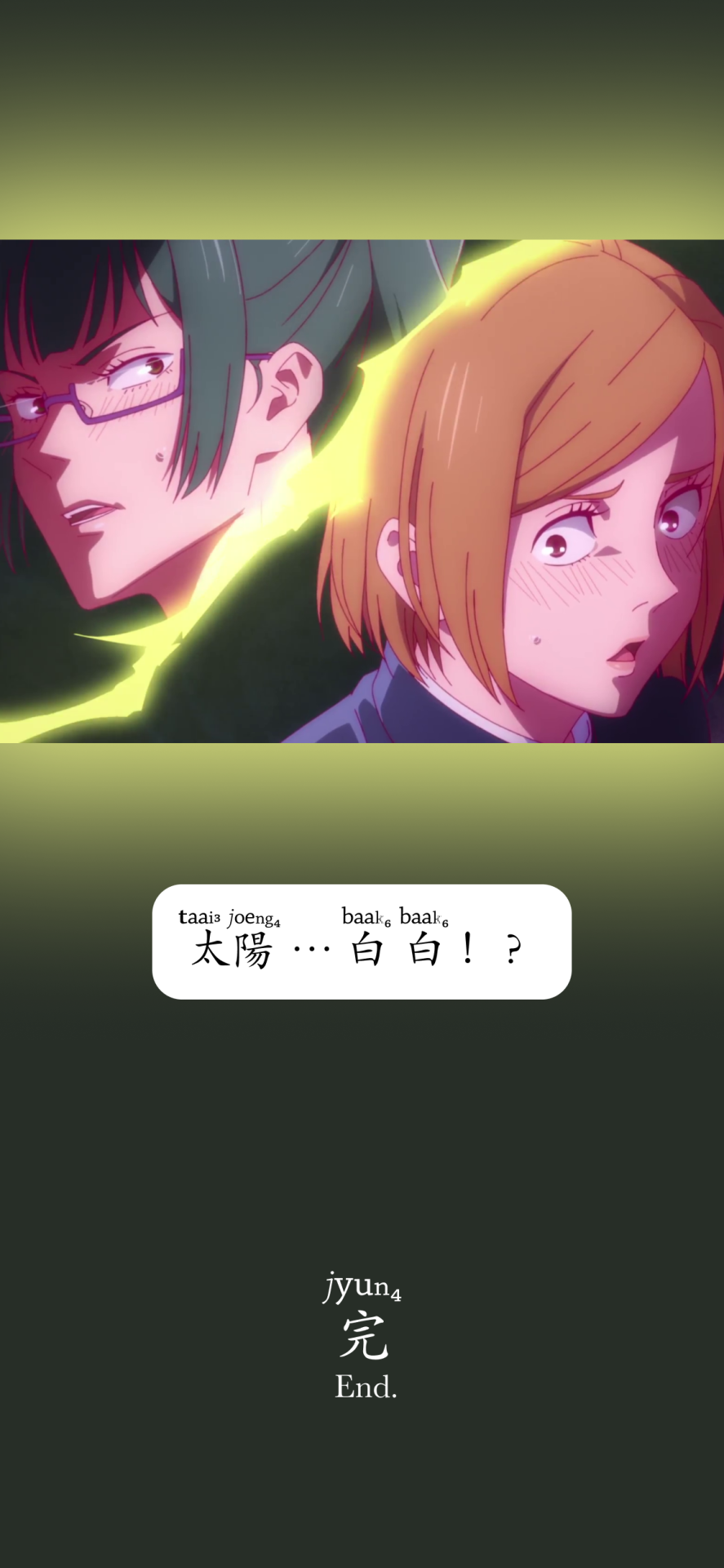
My attempt at transcribing the Cantonese dubs for:
《Jujutsu Kaisen - Ep5 Short - Smelly Panda》
✌️
4 notes
·
View notes
Text
if anyone makes fun of his canto name it's on sight btw <3
#gaming genshin#some ppl were saying it would be way better to just have made ga his surname and ming his given name like yun jin#and YEAH brother i do not understand mhys direction sometimes like way to fuck up a certain part of the fandom's perception of a perfectly#fine character lol#ga ming would have had the same effect and it's 10x less silly in the eng vers#i dont wanna use like wade giles etc bc wow shittiest romanization ive ever seen <3 but its so weird tagging him like that too#genshin impact#ramblings!#conflicted on jyutping i will see what the general fandom comes up w ig
106 notes
·
View notes
Text
wong fei-hung is like we need a distraction. wing zhu i need you to look that official in the eye and call him a manchurian dog. and wing zhu is like :D
#can you tell i’m really bad with jyutping lol i’m sincerely sorry#once upon a time in china#ryddles
3 notes
·
View notes
Text
mandarin is very easy structure wise like the grammar imo, the hardest part for me is just like speaking/listening wise distinguishing between tones for different words (吗 versus 妈 versus 马; ma versus mā versus mǎ)
(said with the voice of someone whose taken mandarin for years in high school but also with the voice of someone who failed the ap test because they made it completely speaking cuz of covid they changed it up..)
#i wouldve stood a chance..#writing and reading is so much easier as i did not grow up in a mandarin speaking household#but the few words i know in cantonese are ingrained in me from when i was little and my mom would say them.#idfk the jyutping for them though LOL#i need like machine translation assistance with texting my family in mandarin bc i dont knwo all the characters#but i understand the grammar. its just a matter of committing new words to memory. SIGH...
5 notes
·
View notes
Text
that said to be fair trying to EXPLAIN over text how chinese sounds. sound. and the rules for them. is like. Hard. u with j always makes the ü sound so it’s not indicated specially and if it sounds like ju then it’s actually zhu, and y and u always make yü, and q and u always make qü. m and u never make mü it’s always mu, same with all the other consonants EXCEPT for l, which can make lu OR lü, and n, which can make nü OR nu, and thus in both cases is indicated to clear up possible misunderstandings (on a phone keyboard v corresponds to ü for this reason). y is ALWAYS a consonant and when paired with i (as in yisheng or yi ge) is often silent/unvoiced. and don’t get me STARTED on regional pronunciation variations (taiwanese sh as s, shui vs shei, etc etc etc). the northern habit of using ’(e)r at the end of your words constantly that i am party to that sometimes drastically alters a word’s sound (会 as hui vs hua’r and more!). and that’s just the things i can think of as someone who has yet to go through linguistics training just from speaking it natively. there’s definitely FAR more that i’m missing. not going to stop me from getting judgemental though because i am first and foremost an utter bitch.
#and that’s just for hanyu/mandarin. canto has its own whole romanisation system (jyutping). and all the other dialects/languages#c.txt
6 notes
·
View notes
Note
how many languages do you speak? this is so random idk…
It's not that random, don't worry about it <3
And technically I can speak two languages. Chinese and English. But under the Chinese language umbrella, I speak both Cantonese and (though much less fluently) Mandarin/Putonghua. But Cantonese and Putonghua aren't really mutually intelligible? But I don't do linguistics so this is not really my place to speak on that. I also know very very tiny bits of French because I learnt it for a bit but stopped because of the pandemic... (so I probably forgot a lot of it orz so we don't count that)
#it always gives me a headache when people say they read Mandarin because... it's Chinese not mandarin *head in hands*#you speak Manadrin you don't write in Manadrin...#anyways#also just a quick tip if you decide to learn Chinese learn Mandarin not Cantonese lol (if you're an English speaker) Mandarin has pinyin#which makes it easier like we do have jyutping for Canto but I think the sounds are harder to pronounce... also Canto has more tones than#Mandarin and Manadrin uses simplified Chinese which is easier to write vs traditional Chinese which typical Canto speakers are taught#but swearing is far more satisfying in Canto I can say that lmao#asks💌#lovely anon❤
6 notes
·
View notes
Text
hey 🇭🇰Cantonese🇲🇴 learners!
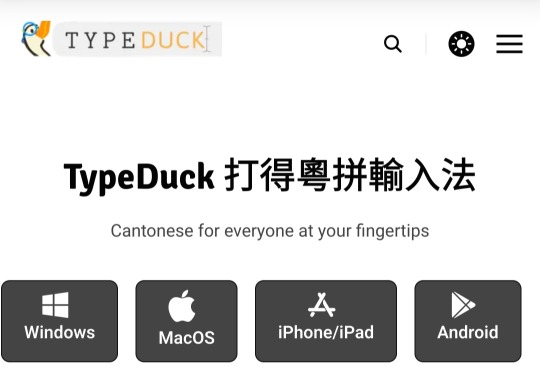
I got recommended this keyboard App called TypeDuck🦆by anwar @ Insta that you may like to check out! (If you haven't heard of, or aren't already using, that is!)
Even though I have yet to try it (long story involving my phone being wonky so I can't install this for myself, for now), cantonese4parents @ Insta already has, and it's available on Playstore, so I'd expect it has been vetted safe enough!
Apparently if you use this keyboard to type out in 粵拼 Jyutping (Cantonese Romanisation, equivalent to Mandarin's Pinyin system), it will show you not only the Jyutping spelling but also the English meaning alongside the 漢字 Chinese characters! ↓


Besides English, it apparently supports some less common language translations like “Hindi, Nepali and Urdu” (quoting from their website) too.
Very useful I think, for anyone who's not good at recognising/mapping the 漢字 to the 粵拼 yet! 😺
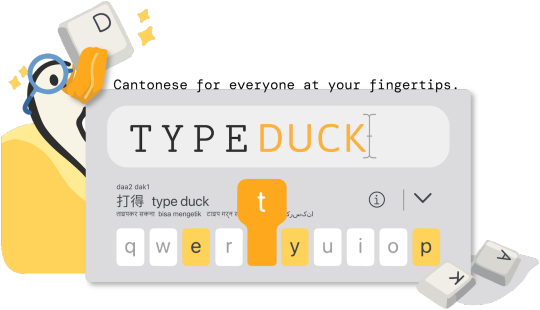
Trivia: If you're wondering why this App is called “TypeDuck” 🦆, it's because it's a play on 打得 in Cantonese (Jyutping: daa² dak¹), which means “able to type”! Great pun! Yes? 😸
36 notes
·
View notes
Text
The cash or qian was a type of coin of China and the Sinosphere, used from the 4th century BC until the 20th century AD, characterised by their round outer shape and a square center hole (Chinese: 方穿; pinyin: fāng chuān; Jyutping: fong1 cyun1; Pe̍h-ōe-jī: hong-chhoan). Originally cast during the Warring States period, these coins continued to be used for the entirety of Imperial China. The last Chinese cash coins were cast in the first year of the Republic of China. Generally most cash coins were made from copper or bronze alloys, with iron, lead, and zinc coins occasionally used less often throughout Chinese history. Rare silver and gold cash coins were also produced. During most of their production, cash coins were cast, but during the late Qing dynasty, machine-struck cash coins began to be made. As the cash coins produced over Chinese history were similar, thousand year old cash coins produced during the Northern Song dynasty continued to circulate as valid currency well into the early twentieth century
35 notes
·
View notes
Note
hi ash, i think i may have asked this before, but from one asian diaspora to another, i was wondering how, if you're able to, you keep up with your chinese practice in a country that's dominated by english (and/or french canadian since ik you live in canada). bc i know a lot of suggestions are like turning your tech to the language you want to learn, put sticky notes on objects with the name in the language you want to learn, etc. but like. i feel like it doesn't matter how much i try and practice bc i'm not in a class, so i don't get it consistently enough, and the rest of my day is filled with english bc, well, that's my first language, and what is needed for my job and every day living. do you have any recs, strategies, or tips? i'm getting desperate; i used to be so much better than i am now. thanks!
hi! honestly, most of my chinese upkeep since i stopped taking mandarin classes (which tbh was relatively recent; this april, and then i'll be taking a cantonese class next term so i can learn to read it) has been a lot less I Need To Practice My Chinese through exercises or dedicated study time, and more just making sure i have frequent exposure to the language that i'm also engaged in. which is a long way to say that basically c-media is how i'm maintaining my proficiency.
i listen to music, i watch dramas and variety shows, look up other vids on bilibili that catch my interest, sometimes read articles, and (very slowly) read fanfic, with pleco open to note new words. just generally scrolling through chinese social media has helped too. having that environment i can immerse myself in helps me learn new vocabulary and practice using what i already know + listening skills, but it also doesn't feel like work or study, just dealing with things i like and am interested in. (this is important for me because i'm so exhausted when i get home every day lmao, if language upkeep outside of class felt like additional Student Time i might have tapped out on attempting it. this way turning on a c-drama at the end of the day just seems like relaxation first and then chinese exposure on top of it).
just by poking through c-drama or fandom things, i know my vocabulary has definitely expanded since i finished my last class, instead of shrunk. even though i watch c-dramas with english subtitles (or chinese and english depending on the platform), i've still picked up stuff from them, and when it comes to things like variety shows i don't rely on subtitles anymore/make myself not. you absorb a lot more of a language than you think just through exposure, imo. although as a caveat for reading specifically, picking up new characters, recognizing them, and reading has been one of the easier parts of learning chinese for me, when it's probably the inverse for a lot of people. i don't know how well just casually reading things will work as a method for others, ymmv.
the thing that i struggle with is getting opportunities to practice speaking, because it's english in my classes and usually with my friends, and either english or cantonese with my family (and i'm not living with them right now). however, i do have a lot of diaspora friends given that i'm in vancouver, and we occasionally dip into speaking mandarin or cantonese. this isn't perfect, but hopefully in future i'll be able to get more speaking experience somehow. what's also helped me with keeping up pronunciation despite these limits is learning to sing chinese songs. singing is one of my hobbies anyway, so i'll use pinyin or jyutping as a guide (getting better at sightreading characters for singing though!) and it's helped me work on certain sounds i had trouble with, and improved my accent. (watching c-dramas even if i don't speak as often has also aided on that front tbh; i listened to recordings of myself from last year and i sound less canto when i speak mandarin now compared to back then, or even earlier this year).
if you want a place to start that i personally think has helped me maintain chinese proficiency, i would choose a variety show you're interested in and try watching it without english subtitles, when you've got free time and want to do something fun. most will have chinese ones you can use to practice reading along with listening, and people usually speak at a conversational enough level that it shouldn't be too difficult to follow along (for ref, after a year and a half of heritage learner mandarin classes at uni i could watch 《我们的歌》/Our Song without english subtitles and understand most of it). variety shows are also really accessible lmao, so many have full seasons on youtube.
tl;dr it's been media exposure for me all the way down since i left classes, wherever i can get it.
not sure how actually helpful all this rambling might be, but this is what i do to keep up my chinese proficiency and keep learning in daily life nowadays! hopefully maybe you or someone else will be able to get something out of it :)
#sorry anon i hope this all connects i'm answering this late at night oop#you can ask me clarifying stuff if you want tho!#also for those of you who see this and are still building up a basic vocabulary and language foundation/grammar#please do not feel bad or kick yourself that you can't just throw yourself into the deep end on bilibili and learn chinese that way#all this was targeted to answer a specific question and assumes some kind of existing proficiency#i believe in y'all to get there one day tho!!! 努力学习 加油吧#languages#mandarin#chinese#ashton answers#anon
24 notes
·
View notes
Text
云上五骁 — to touch the heart
* all dialogue is in cantonese jyutping, review end for translations

with your chopsticks, you grabed a piece of har gow and placed it on jing yuan's plate. it was just like yesterday that he was a young boy, hes grown up so much
"ah, do ze"
jing yuan thanked, making you simply nod your head with a smile before turning your attention to yingxing and baiheng. they were already arguing about who is gonna pay the bill when none of you guys were even finished eating
"bei ngo zou! ngo jau cin"
baiheng insisted, not realizing how loud she was as she was too busy trying to convince yingzing to let her pay the bill
"mou, mou, ngo ho ji" yingxing shook his head, waving his hands in front of him
"me cin?"
dan feng quietly asked in a sarcastic voice, earning a giggle from you baiheng and yingxing probably would have gone on for much longer but luckily jingliu finally spoke up
"mou gong laa. sik sin. ngo bei cin"
jingliu sighed and shook her head, akin to that of a mother scolding her children. jing yuan giggled before eating the har gow you had given him, eyes closing as he enjoys the savory taste of the shrimp
"tim sam, nei bei cin hai ma?"
you asked dan feng with a whisper. dan feng hadnt reply with words but rather a nod. you looked over to see jingliu staring at dan feng. her gaze wasnt cold, but one of acknowledgment
well, in your current predicament you cant really say jinglius stare was so kind now

多謝 (do1 ze6) - thank you
畀我做! 我有錢 (bei2 ngo5 zou6! ngo5 jau6 cin4) - let me do it! i have (the) money
冇, 冇, 我可以 (mou5, mou5, ngo5 ho2 ji3) - no, no, i can do it
乜錢? (me1 cin4?) - what money?
冇講啦. 食先. 我畀做 (mou5 gong2 laa1. sik6 sin1. ngo5 bei2 cin4) - dont talk about it. eat first. ill pay
甜心, 你畀做係嗎? (tim4 sam1, nei5 bei2 cin4 hai6 maa3?) - sweetheart, did you already pay?
har gow / 蝦餃 (haa1 gaau2) is a shrimp dumpling basically
the title is in reference to dimsum (点心) as it directly translates to "touch the heart" [was gonna use 飲茶 (jam2 caa4) but didnt get to]
#‧₊˚ ☁️⋅♡𓂃 ࣪ ִֶָ☾.#hsr#honkai star rail#云上五骁#high cloud quintet#dan feng x reader#kinda#‧₊˚🖇️✩ ₊˚🎧⊹♡#wc : 256#cantonese again#why do i do this to myself#i spent way too long on this
48 notes
·
View notes
Text
why does my ipad know about jyutping on the same settings as my phone but my phone doesnt know about cantonese
#pup talks#funfact every time ive said 佢 was copy pasted becuz it doesnt exist according to my traditional chinese (hong kong) keyboard#佢 is he/she/it in cantonese
7 notes
·
View notes
Text
"Cat" in Chinese is complicated: a short essay
I saw that the Chinese submissions for "cat" (貓/猫 and 小貓/小猫) for the @words-for-cat-bracket didn't have IPA transcripts according to the Google Sheets file, so I'm here to write about the IPA! This was originally going to be an ask but it got kind of long, so I thought it deserves its own post.
Annotation #1: I only speak Cantonese (Hong Kong dialect) and Mandarin (was taught Standard/Northern dialects for 9+ years, personally speak with a Southern/Cantonese accent), so I sadly cannot provide pronunciations for other Chinese varieties or their words for "cat".
Annotation #2: I am adding the specific vowel names because of Tumblr desktop ask/post font limitations when I initially wrote the post.
貓/猫 ("cat")
Standard Mandarin: māo (pinyin) → [mɑu̯˥]; the first half of the diphthong is the open back unrounded vowel, at least that is how I pronounce it
Cantonese: maau1 (Jyutping) / māau (Yale) → [maːu˥]; the first half of the diphthong is an open central unrounded vowel
小貓/小猫 ("little cat; kitten")
Standard Mandarin: xiǎomāo (pinyin) → [ɕjau̯˩ mɑu̯˥]; same vowel diphthong notes as above
Cantonese: siu2 maau1 (Jyutping) / síu māau (Yale) → [siːu˧˥ maːu˥]; not colloquial Cantonese, refer to additional linguistics notes for details
Additional linguistics notes
The diminutive prefix 小 is actually not commonly used in Cantonese; we have a bit of diglossia going on in Cantonese-speaking regions, where colloquial Cantonese is Low and Mandarin/Std. Chinese is High. (Technically, both Mandarin/Std. Chinese and English are High, at least in Hong Kong, but in the context of the conversation, Mandarin/Std. Chinese is High.)
Us Cantonese speakers only really say 小貓/小猫 if we are reading a text written in Written Standard Chinese, which is based on Mandarin. In colloquial Cantonese, we say 貓仔/猫仔 [maːu˥ tsɐi˧˥]; maau1 zai1 (Jyutping) or māau jái (Yale), with a different diminutive suffix instead of a prefix.
Mandarin also has a diminutive suffix, 兒/儿 (IPA can change depending on the syllable it's used on); it is usually ér in pinyin but in the context of the diminutive, it is shortened to an -r suffix and there is a whole set of rules surrounding it regarding pronunciation. This érhuà system is only really used in North China, rarely in the South (including Taiwan).
Both 貓兒/猫儿 [mau̯˞˥] (pinyin: māor) and 小貓兒/小猫儿 [ɕjau̯˩ mau̯˞˥] (pinyin: xiǎomāor) are valid forms of the word-phrases in Northern dialects of Mandarin. Heck, if you look at the dialectal synonyms chart on the Wiktionary page, you will even see that the latter version (小貓兒/小猫儿) is the preferred variant for "kitten" used in Beijing.
Conclusion
This got really unexpectedly long, which is why I split this into its own post. I know that @/words-for-cat-bracket no longer accepts submissions into the bracket for the Chinese words for "cat" I wrote about in the "Additional linguistics notes" section of this post, and I am fine with it.
I will, however, request that 小貓/小猫 be described in the bracket to be the word-phrase for kitten in Mandarin specifically, not in Cantonese or Chinese in general.
TL;DR: Submitted pronunciation IPA for the Mandarin and Cantonese word-phrases for "cat". The Sinitic languages mostly share a writing system but are linguistically Complicated.
35 notes
·
View notes